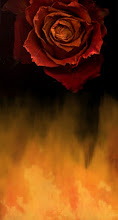Greetings PNR friends, peers, and (frequently) fantatics!
As many of my beloved stalkers...er, Facebook-savvy fans know, I have been hard at work creating the comic book version of my PNR urban fantasy/adventure novel, Black Dog and Rebel Rose. This dark paranormal has just about everything: sex, tattoos, motorcycles, vampyre slaying (resplendent with blood splatter and awesome horror gore), angels, demons, a headstrong Nephil huntress who likes things done HER way, and a half-demon bad boy known for rocking a woman's world (note the illustration above--;-). A story I loved writing and that I STILL love in prose...and yet one that I always felt would work BEST as a comic.
I have begun posting the fruits of my continuing labors on my Facebook page, and the response has been awesome. Lots of folks are asking: how does it work? What is the process of creating a comic book page? Even those who have no interest in comics--which, I'm sure, involves much of the PNR reading world--are still interested in the process. So...*drumroll please**...here you go! Creating a comic...in pictures!
Now, I will not be illustrating this using all the same page artwork each time...hopefully this will make things more interesting and still be easy to follow.
STEP 1: THE SKETCH
Not too impressive, I know...but this is just the beginning. :-)
To give myself an idea for how a page should be laid out, I will create a very scribbly looking sketch of where characters should be placed, how panels should work out, etc. In this case, my heroine is riding her Ducati Monster along a dirt road, where she spots a vulture eating roadkill and proceeds to have an intense flashback regarding her mother's death. Can you see that in this drawing? HELL NO! But I can, and that's all we need at this point.
STEP TWO: FINAL PENCIL SKETCH
Now, in the "old school" of comics, pencils would usually be tighter than this. Some artists still make their pencils as tight as any finished drawing for a comic page. I do not, since I am working digitally in a program called Manga Studio, a program specifically designed for comics creation and publication and allows me to create cutting-edge artwork demanded by the industry standard, and I don't need pencils to be so final. Dialogue bubbles are added as a "guide".
STEP THREE: DEFINING PENCILS/ INKING
Here you will see a definite "in process" shot. Again, not super impressive, but important nonetheless. :-) In this particular example, I have eliminated parts of the pencil art and drawn in sketchy areas in blue--these would be called "non photo blue" sketches (because if you are doing this art on paper rather than digitally, sketches would be done using a special blue pencil that would allow you to sketch parts of the drawing that won't show up when scanned/printed). You can see part of the page has already been inked a bit. The red line allows me to plot the flow of the page to make sure it will make sense before it is finalized in ink.
STEP FOUR: FINAL INKING
We're getting there! Clean inking is applied digitally, and a grey background is applied (this particular comic is being created in black, grey and white tones with eyes in color only). I have also already colored the eyes in here, and applied the final panel layouts.
Here it is!!! The final colored page! All we need now is to add dialogue bubbles and narration and...presto!!! We have a finished page! :-D
Looks pretty different from the first example, huh? :-)
--Danielle
TAG!! You're it! Find me online:
http://www.danielledsmith.com
Facebook: https://www.facebook.com/danielle.d.smith.10?ref=tn_tnmn
Twitter: @DaniDSmith
Check out the original Black Dog and Rebel Rose story on Amazon (also available everywhere else):
http://tinyurl.com/BD-RRKINDLE







1 comment:
I wish I had your talent sweets. I reckon it's great you show us how these are done, shows just how much hard work it takes for you to produce something so awesome.
Post a Comment